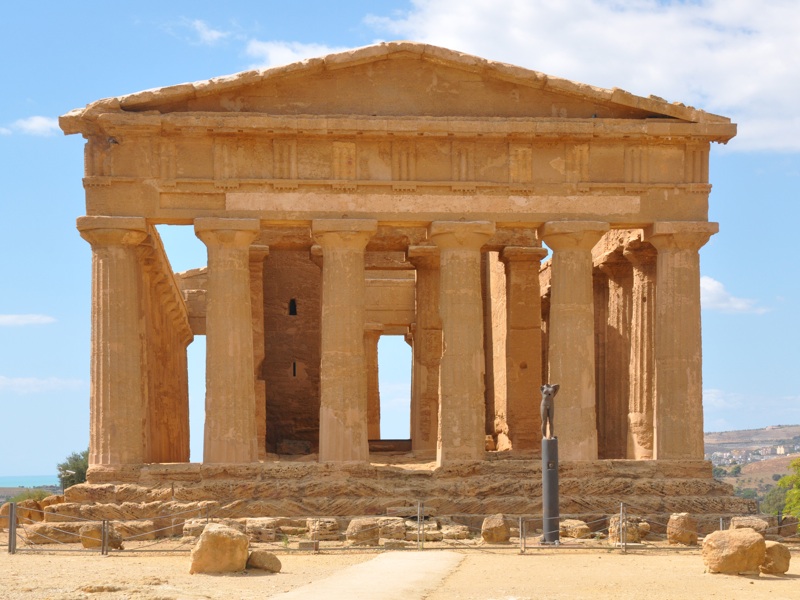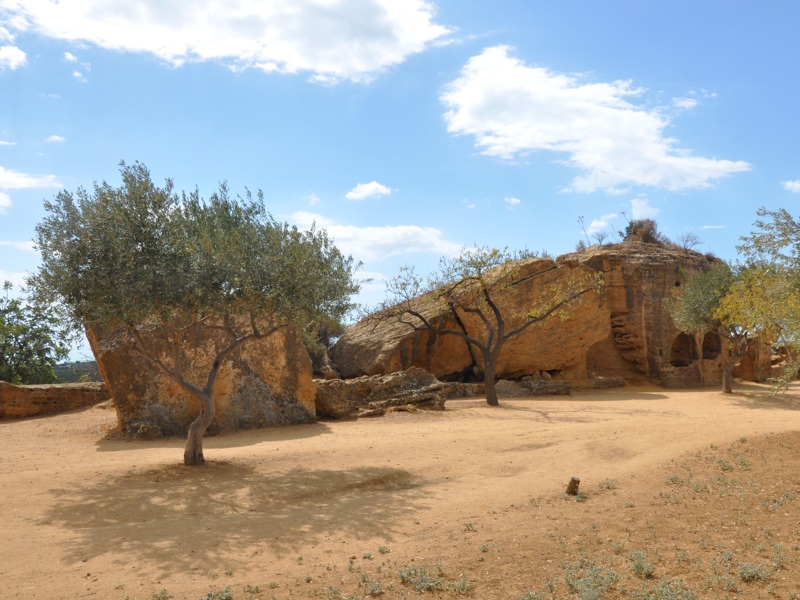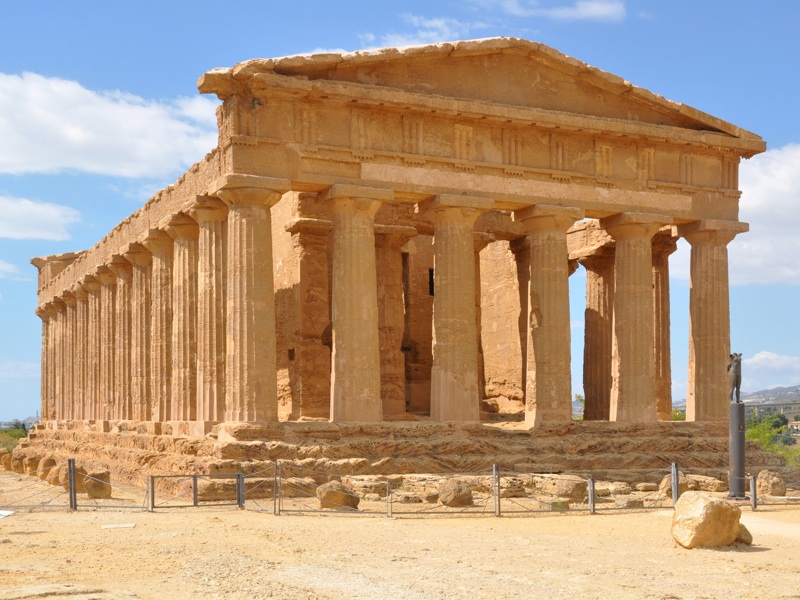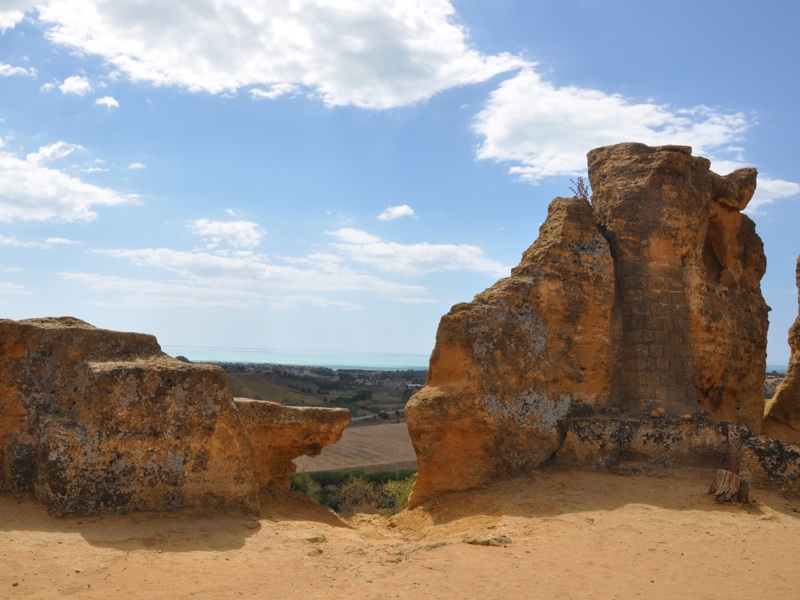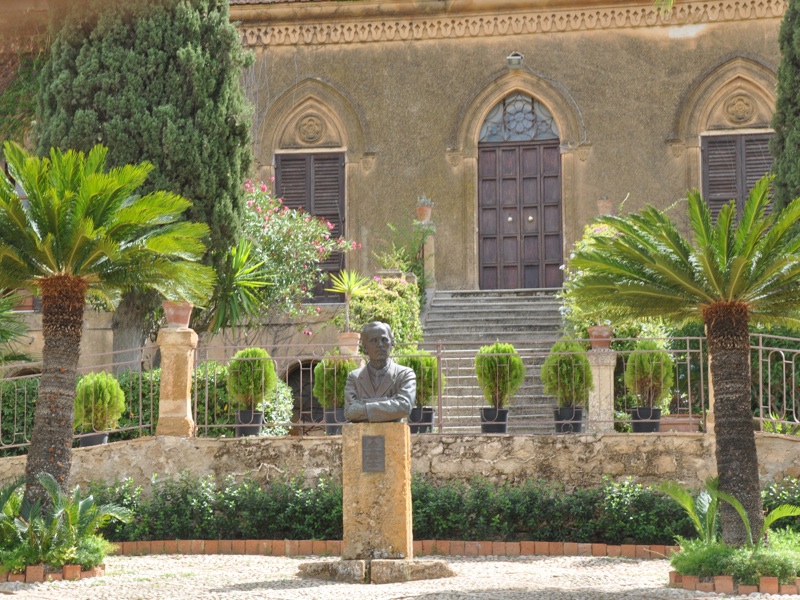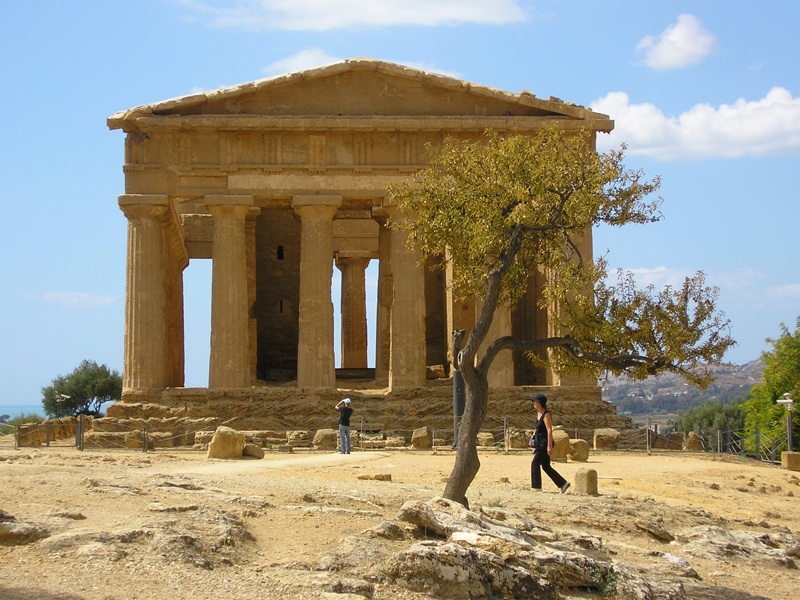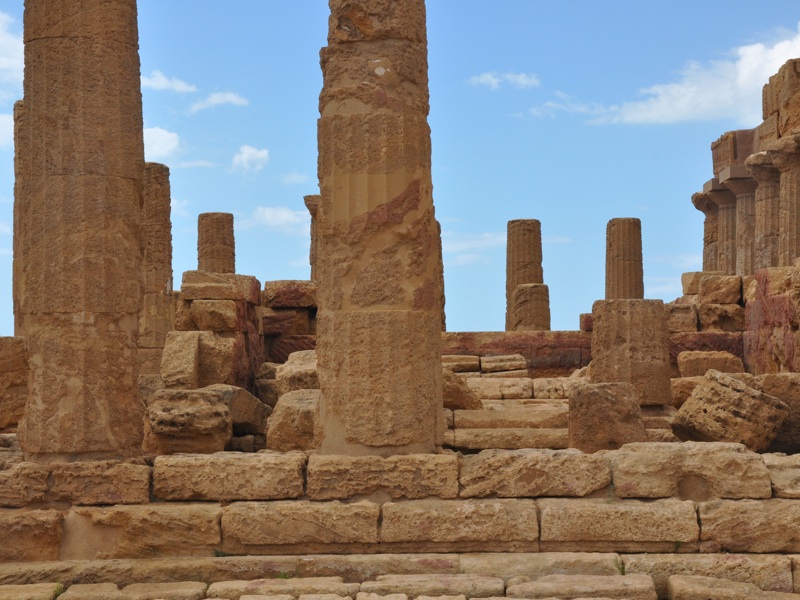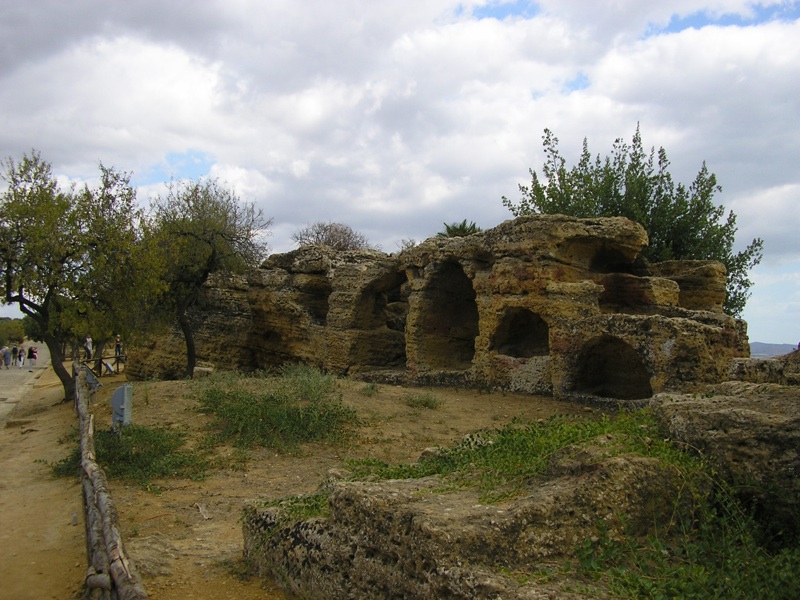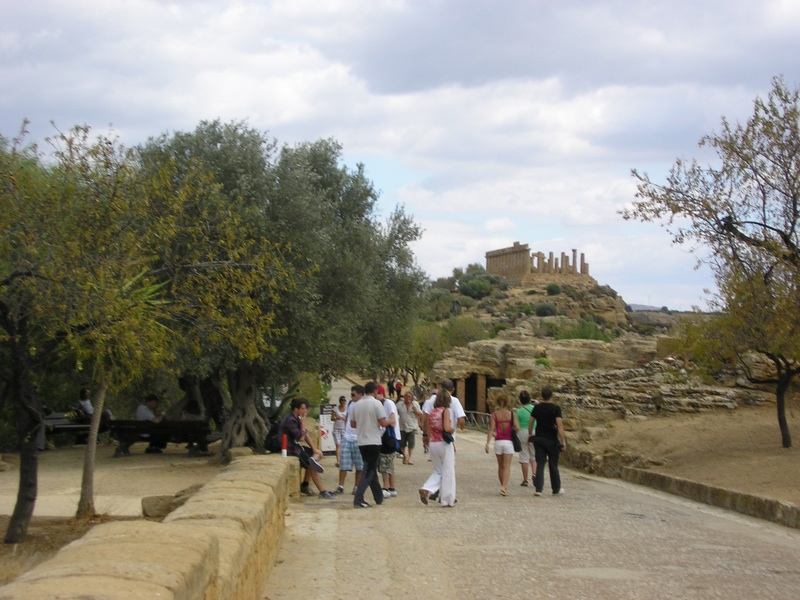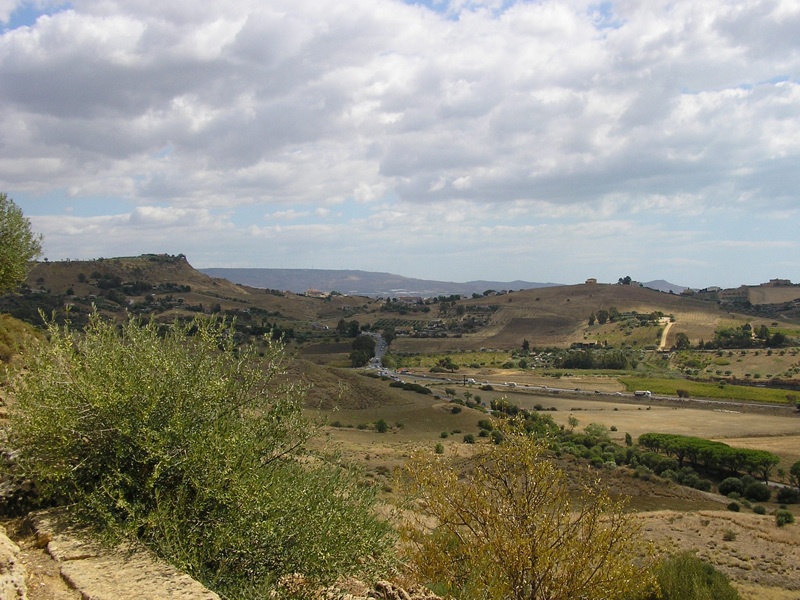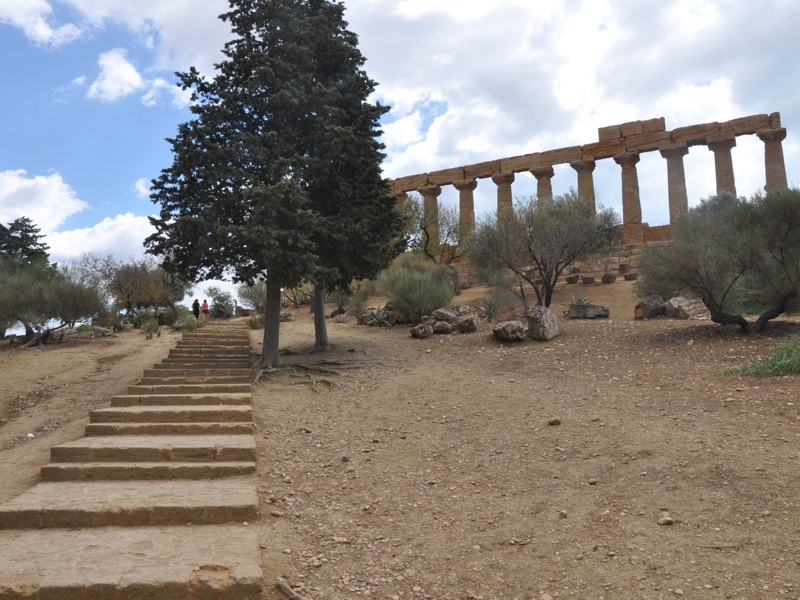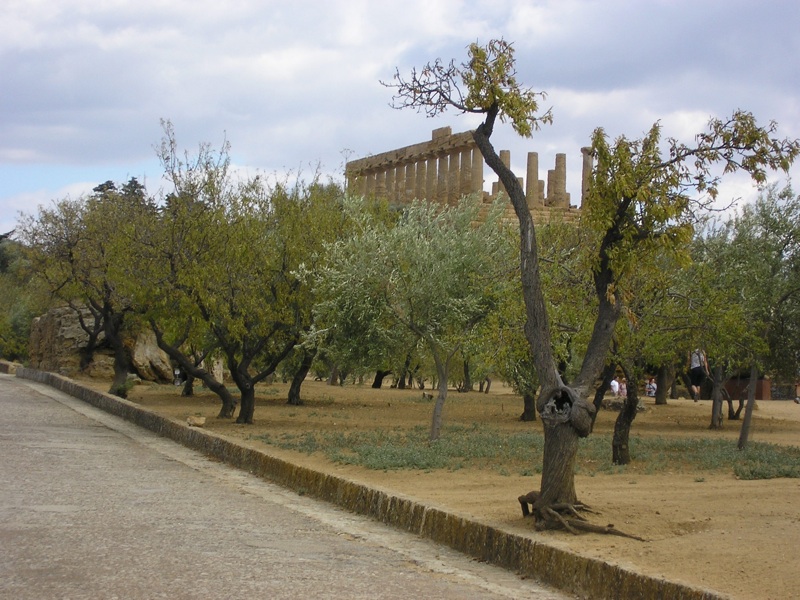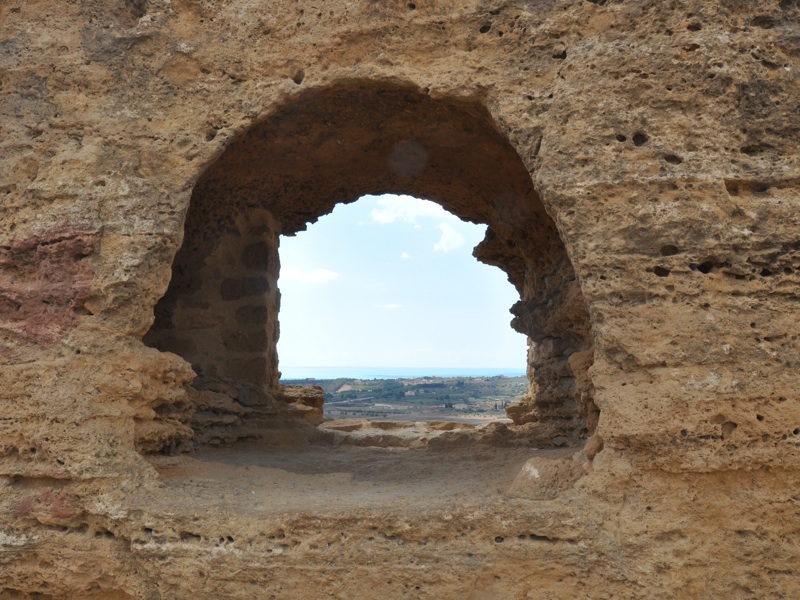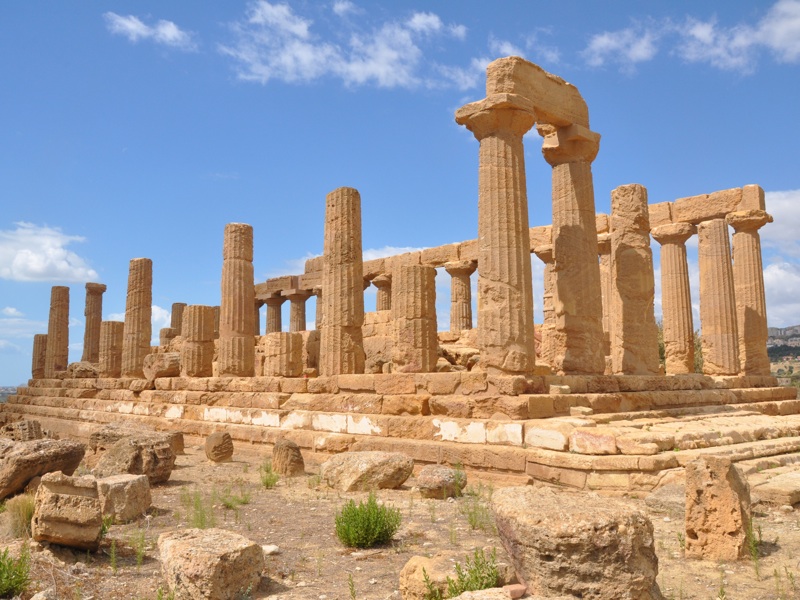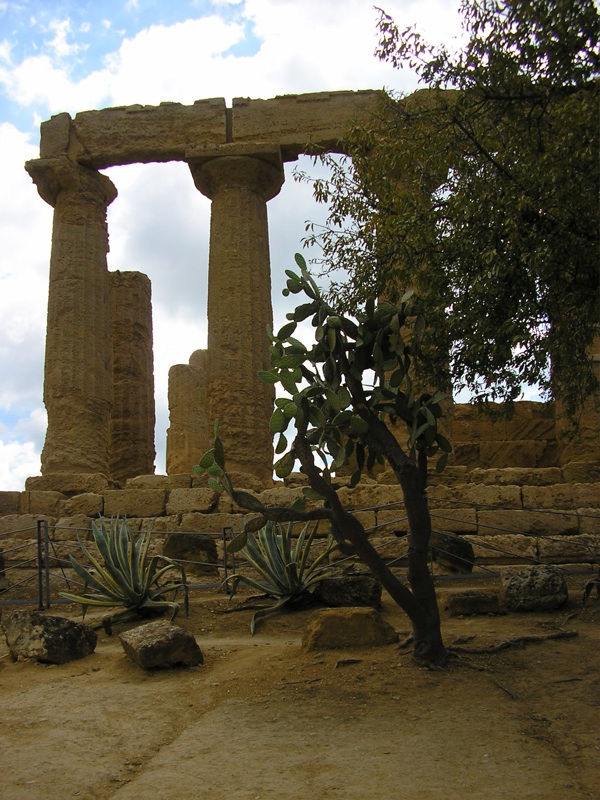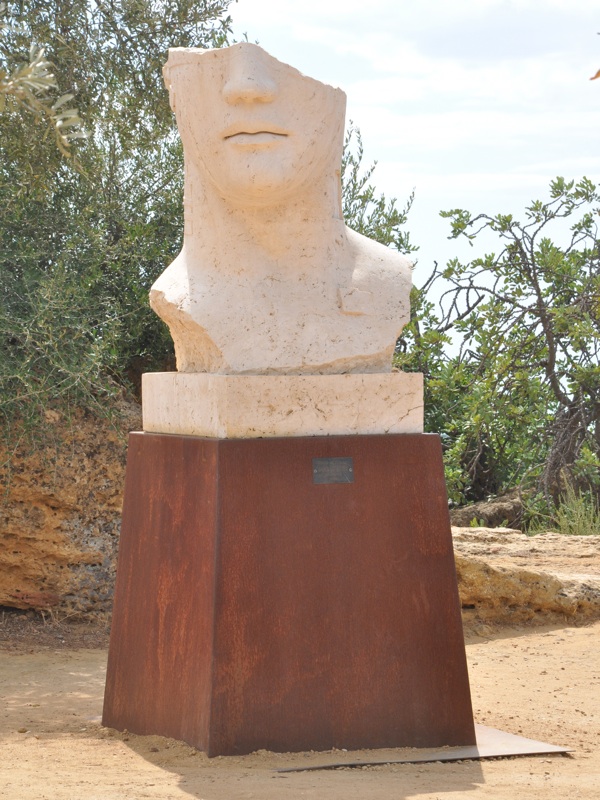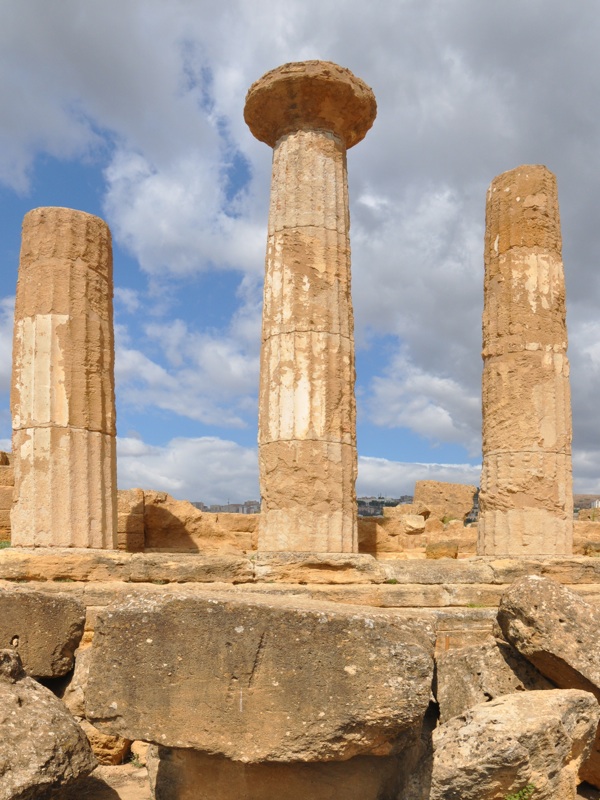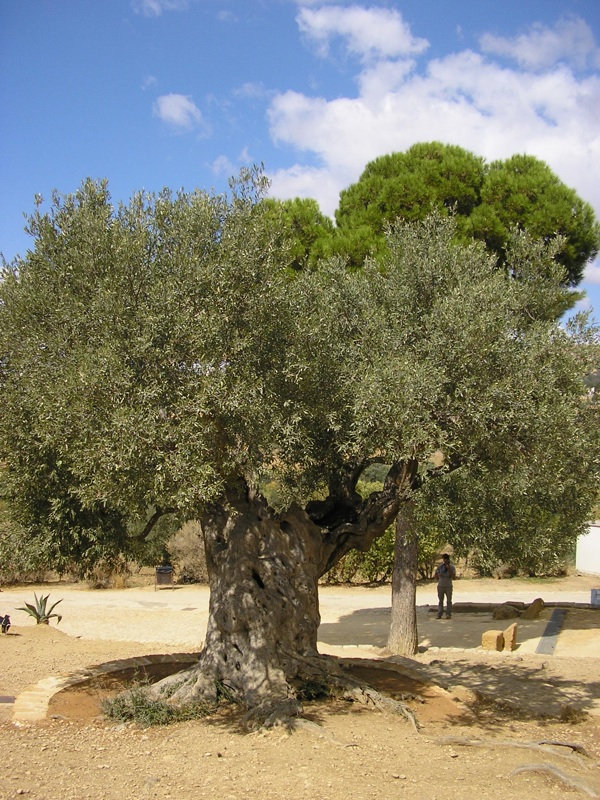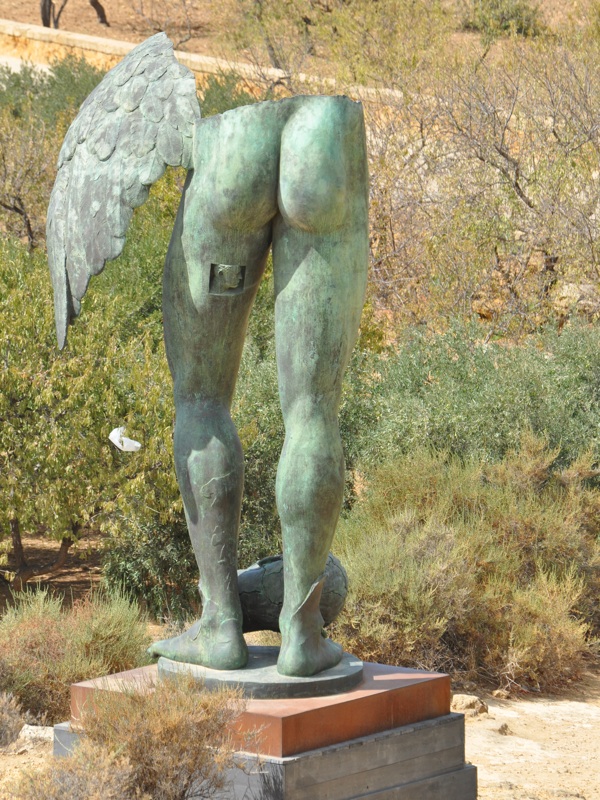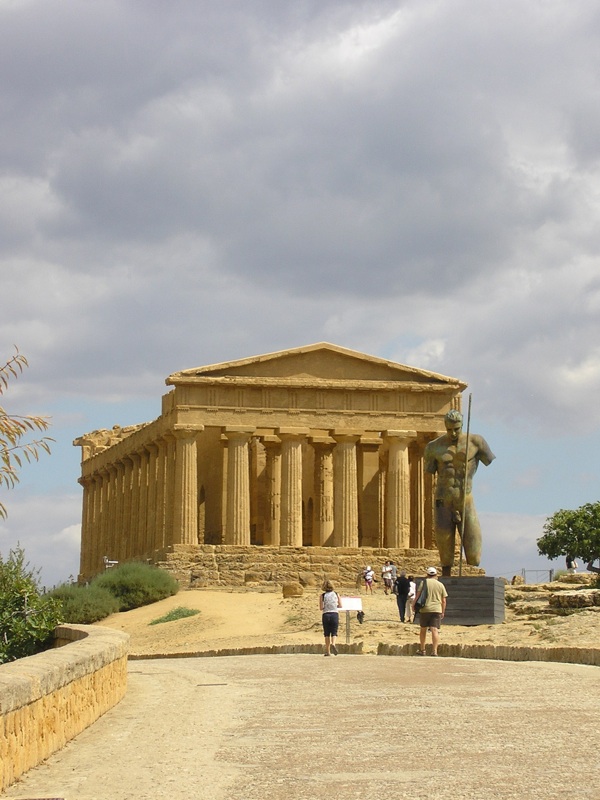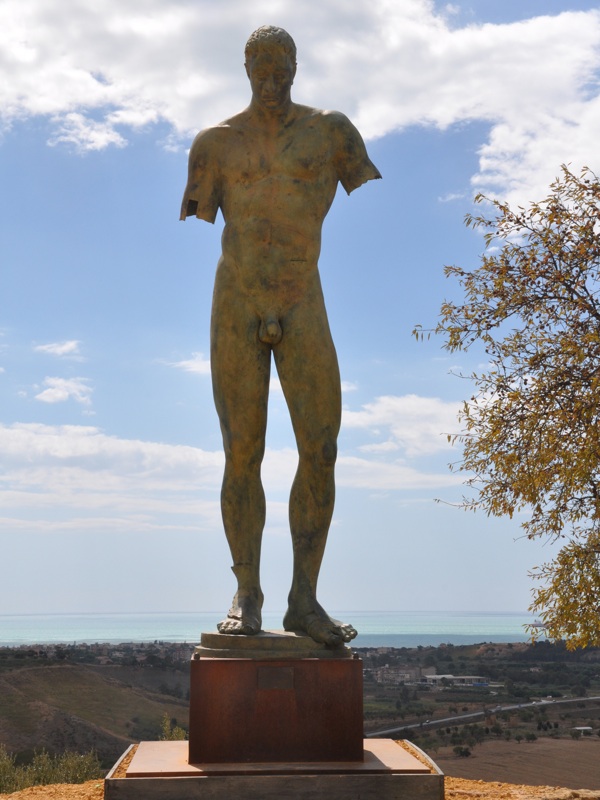Agrigento is a city with approx. 60,000 inhabitants, located on the south coast of Sicily, 127 km south of Palermo  , 168 km west of Catania
, 168 km west of Catania  (➤
map)(➤ map). The city was founded by Greek colonists in the 6th century BC under the name of Akragas (Ἀκράγας) and for a time was one of the most powerful political and military centers of Great Greece in Sicily. Today, Agrigento is the capital of the agricultural province of the same name, an important commercial center and one of the most important tourist destinations in Sicily, famous mainly for the so-called The Valley of the Temples (Valle dei Templi) - a vast archaeological site with the remains of Greek temples from the 6th and 5th centuries BCE, considered one of the most outstanding examples of architecture and art in Great Greece.
(➤
map)(➤ map). The city was founded by Greek colonists in the 6th century BC under the name of Akragas (Ἀκράγας) and for a time was one of the most powerful political and military centers of Great Greece in Sicily. Today, Agrigento is the capital of the agricultural province of the same name, an important commercial center and one of the most important tourist destinations in Sicily, famous mainly for the so-called The Valley of the Temples (Valle dei Templi) - a vast archaeological site with the remains of Greek temples from the 6th and 5th centuries BCE, considered one of the most outstanding examples of architecture and art in Great Greece.
AGRIGENTO
Tempio della Concordia
photo: AL
Akragas was founded in 582 BCE by Greek colonists, inhabitants of existing since 688 BCE Geli, founded by newcomers from Crete and Rhodes. The 6th and especially the 5th century BC is the period of the city's greatest power and its economic and cultural boom; in 480 B.C.E. the coalition of Syracuse, Geli and Akragas (where the tyrant Teron ruled at the time) defeated the Carthaginians led by Hamilcar, Hannibal's father, in the great battle of Himera. At the end of the 5th century BC the city, surrounded by 10 km long defensive walls, had over 200,000 inhabitants and ruled over a large part of Sicily. During this period, most of the temples were built (including the so-called Temple of Concord, Tempio della Concordia), the remains of which today attract tourists from all over the world to Agrigento.
AGRIGENTO
the main avenue of Valle dei Templi and the temple of Hera (Juno) in the background
photo: AL
After the death of Teron in 473 BCE the power was taken over by his son Trasdeus, expelled after two years by the inhabitants of the city, who - on the advice of the aforementioned Empedocles and according to the rules proposed by him - introduced a democratic system in Akragas. The city functioned as a strong economic and political center for several dozen years, but in 406 BCE, after a long siege, it was conquered and almost completely destroyed by the Carthaginians. After this event, Akragas, although later partially rebuilt, did not fully regain its former glory, recovering only after 210 BCE, when as a result of the Second Punic War it was in the hands of the Romans (who changed the name of the city to Agrigentum) and for the next several centuries it experienced a period of development again, but as a city under Roman rule, and not as an independent political organism.
AGRIGENTO
view of the city from Valle dei Templi, in the foreground one of the sculptures by Igor Mitoraj
photo: AL
After the fall of the Roman Empire, the city experienced several barabrian invasions; later, in 535, captured by Belisarius, it came under the rule of Byzantium for a long time. In 828, the city was taken over by the Arabs - the Berber dynasty, which conquered it, moved the city center to a hill (more or less where today's Agrigento is located), rebuilding the fortification system accordingly. In 1087, Sicily was conquered by the Normans: during the reign of Roger I, a Roman Catholic bishopric was established in Agrigento, numerous churches were built, another period of prosperity and development began (it is worth knowing that the city was called Girgenti at that time and that the name was used until 1927, when in Mussolini's Italy, the cities were restored to the names under which they were known in the Roman Empire - henceforth the city is called Agrigento). After the Norman era, the city fell into decline, only to recover again in the 18th century. In 1860 it enthusiastically supported Garibaldi and soon found itself within the borders of a united Italy.
AGRIGENTO
landscape and vegetation of the Valle dei Templi
photo: AL
For the vast majority of tourists, the main attraction of Agrigento is the so-called The Valley of the Temples (Valle dei Templi) - a vast area located south of today's Agrigento and slightly lower than the city itself, but, contrary to its name, not in the valley, but also on the latitudinally low mountain ridge, making it extremely rich (and not entirely still explored) archaeological zone, with the remains of Greek temples built in the 6th and 5th centuries BCE, the remains of Akragas defensive walls and the remains of an early Christian necropolis (on both sides of the main road running along the Valle dei Templi, between the Temple of Heracles and Tempio della Concordia), as well as from an extensive "Greco-Roman quarter", a remnant of the urban complex from post-classical times. The oldest monuments of the Valle dei Templi are considered to be one of the most outstanding examples of architecture and art in Great Greece and one of the greatest tourist attractions in Sicily, although most temples (except the Temple of Hera and Tempio della Concordia) have little left - partly as a result of damage caused by Carthaginians in 406 BCE, partly as a result of damage done much later, in Christian times (when, for example, Greek temples, in particular the gigantic temple of Zeus, were treated as a quarry, a source of building materials), partly also as a result of earthquakes and after just the passage of time.
It is impossible to fit a detailed description of Valle dei Templi in a few paragraphs. Only the main landmarks are marked on the map below, and in the description below the map we provide some tips for tourists who want to see at least the most important monuments located here.
With

and

two main car parks, located near the road that runs near the temples, are marked. A large parking lot marked with a marker

is located near the San Nicola church complex

, "Greco-Roman Quarter"

, and the archaeological museum

(Museo Archeologico Regionale).
AGRIGENTO
landscape of the Valle dei Templi
photo: AL
One of the good strategies for visiting the Valle dei Templi is to leave the car in the latter parking lot and start your tour with a visit to the museum, located partly in the former convent of San Nicola (Convento di San Nicola). Finds from excavations in the region of Agrigento are exhibited here, from prehistoric times, the period of Greek colonization, as well as the early Christian era. The most famous exhibits include: a huge telamon (atlant) from the temple of Zeus (the only surviving one of several dozen that once existed), a 5th century BC marble statue known as the
Efeb of Agrigento, and a collection of Attic vases with the famous
Krater Dionysus. The church of San Nicola itself was built in the 13th century by Cistercians (who used elements of the ruins of the temple of Zeus as building materials

). Inside the church, it is worth paying attention to, among others, on one of the chapels with the famous sarcophagus from the 3rd century with a bas-relief depicting
Phaedra and Hippolytus, as well as a wooden 13th-century crucifix known as
le Signore delle Nave. From the terrace in front of the church there is a view of the Valle dei Templi.
AGRIGENTO
temple of Heracles
photo: AL
Many tourists start their tour of Valle dei Templi near the car park

. The marker

on the map above refers to the place where the Doric temple of Olympian Zeus once stood. Erected in the 5th century BCE, according to some sources, perhaps the largest temple of this type in history (113 m long and 56 m wide), it was built to commemorate the victory over the Carthaginians in the Battle of Himera, but it does not seem to have been completed - what already existed, was destroyed by the Carthaginians in 406 BCE, after which the construction was discontinued. To this day, little remains, as well as from many other temples in this area - e.g. from the temple of Castor and Pollux from the end of the 5th century BCE, or the sanctuary dedicated to Demeter and Persephone. A little more is preserved from the Temple of Heracles

(Tempio di Eracle), probably the oldest temple in the Valley of the Temples. Thanks to the support of Alexander Hardcastle (1872-1933), British naval officer, philanthropist passionate about archeology, living in Agrigento since the beginning of the 20th century, managed to rebuild the 8 original columns of the temple of Heracles, seen in the photo above (near the temple stands Hardcastle's former residence, known as "Villa Aurea"

, now operating as the Valle dei Templi information center).
AGRIGENTO
Tempio della Concordia
photo: AL
East of the temple of Heracles and "Villa Aurea" stands a well-preserved Doric temple called Tempio della Concordia

(the name comes from a Latin inscription found nearby about some agreements between the contested parties). The temple dates from the 5th century BC; it was destroyed during the invasion of Carthage, but was rebuilt in Roman times, and in 597 CE transformed into a Christian basilica. Further, near the parking lot marked with the marker

, there is also a fairly well-preserved temple of Hera

(with numerous columns and even with an architrave resting on the colonnade on the north side), dating from the 5th century BC, also destroyed in 406 BC, but later rebuilt.
AGRIGENTO
temple of Hera
photo: AL
You need at least half a day to visit the Valle dei Templi very briefly. If you want to visit the archaeological museum, spend more time in the "Greco-Roman quarter", take a walk in the famous garden managed by one of the Italian environmental foundations known as Giardino della Kolymbetra (in the area of the Temple of Zeus, west of it), and also get to the above-mentioned (or not mentioned here at all) less known temples and other monuments - probably not even a whole day will be enough, especially since the area is quite extensive.
The Valle dei Templi is undoubtedly the main tourist attraction of Agrigento. A tourist who is interested not only in the oldest history of the city will also find places of interest in the newer districts of the city.
AGRIGENTO
view of the city from Valle dei Templi
photo: AL
You can start your walk from the cathedral

(Cattedrale di San Gerlando), whose history dates back to the 11th century BC; the oldest fragments of the building erected in Norman times can be seen from the Via Duomo (later the temple was rebuilt and restored many times). Other churches of Agrigento worth seeing include Santa Maria dei Greci

, a 14th century temple with the relics of the Greek temple where it was built, the 18th century church of San Lorenzo

(also with the remains of an earlier temple), as well as the church of Santo Spirito founded in the 13th century

and the adjoining Cistercian monastery. South of the cathedral, at the marker

, is Piazza Pirandello; the imposing building on this square houses the town hall, Municipio, and Agrigento's most important theater, Teatro Pirandello. Walking from here one of the main shopping streets of Agrigento, Via Atenea

, to the southeast, after a few dozen minutes you reach a large square adjacent to the even larger Piazza square Vittorio Emanuele

, which forms the border between the historic districts of Agrigento (west of it) and the newer parts of the city.
If you have time to visit the vicinity of Agrigento, it is worth going to Porto Empedocle

, a town named after Empedocles (one of the most important philosophers of Greek before Socrates, born around 490 BCE in Akragas). The town itself is not particularly interesting; however, it is worth knowing that when driving from Agrigento towards Porto Empedocle you drive close to the place (marked with the marker

) where the farmhouse stands in which the Italian playwright, laureate of the Nobel Prize in Literature, Luigi Pirandello, was born (part of the building is occupied by a museum devoted to the writer). Anyone interested in visiting this place should take the SS115qtr towards Porto Empedocle, head towards Villaseta and look for the appropriate signs for "Casa Natale de Luigi Pirandello".

 , 168 km west of
, 168 km west of 
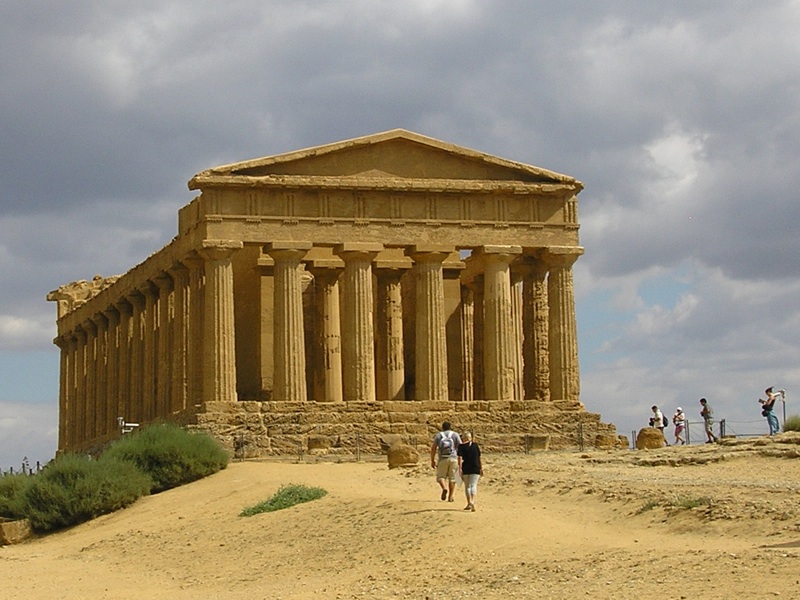


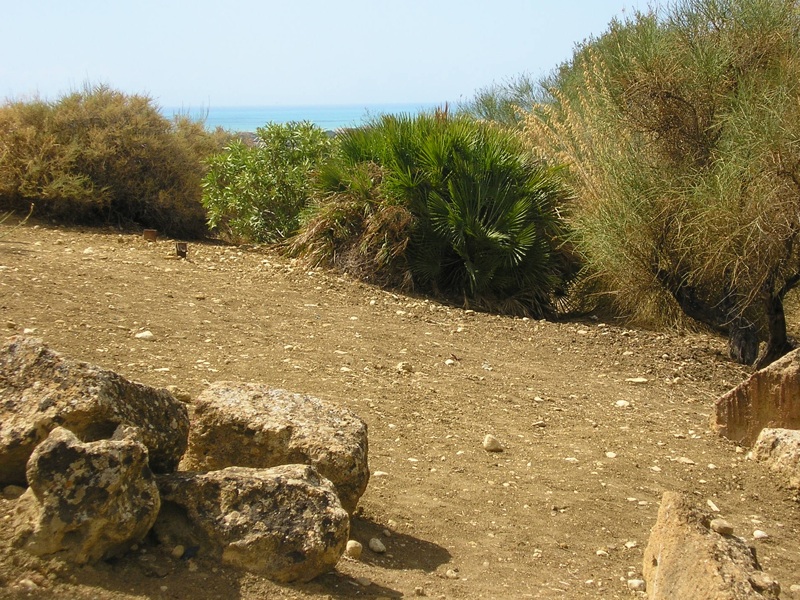
 and
and  two main car parks, located near the road that runs near the temples, are marked. A large parking lot marked with a marker
two main car parks, located near the road that runs near the temples, are marked. A large parking lot marked with a marker  is located near the San Nicola church complex
is located near the San Nicola church complex  , "Greco-Roman Quarter"
, "Greco-Roman Quarter"  , and the archaeological museum
, and the archaeological museum  (Museo Archeologico Regionale).
(Museo Archeologico Regionale). 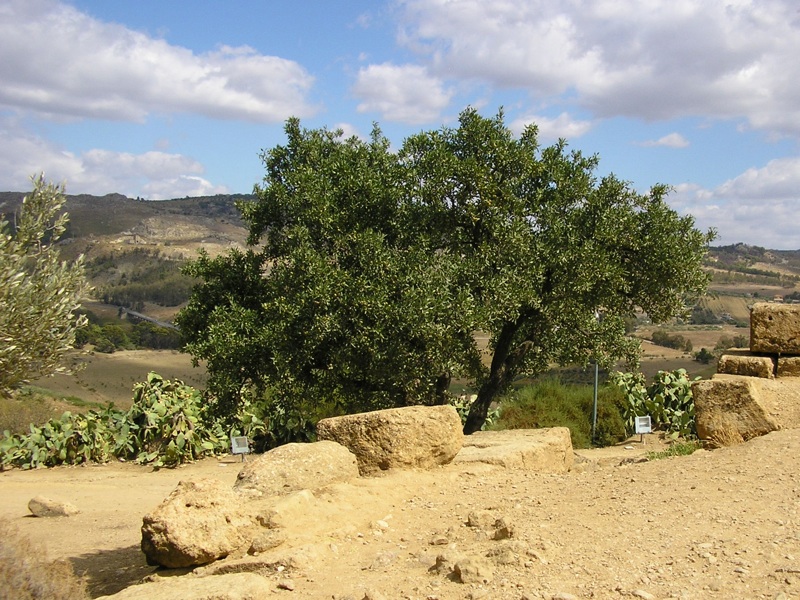
 ). Inside the church, it is worth paying attention to, among others, on one of the chapels with the famous sarcophagus from the 3rd century with a bas-relief depicting Phaedra and Hippolytus, as well as a wooden 13th-century crucifix known as le Signore delle Nave. From the terrace in front of the church there is a view of the Valle dei Templi.
). Inside the church, it is worth paying attention to, among others, on one of the chapels with the famous sarcophagus from the 3rd century with a bas-relief depicting Phaedra and Hippolytus, as well as a wooden 13th-century crucifix known as le Signore delle Nave. From the terrace in front of the church there is a view of the Valle dei Templi.
 (Tempio di Eracle), probably the oldest temple in the Valley of the Temples. Thanks to the support of Alexander Hardcastle (1872-1933), British naval officer, philanthropist passionate about archeology, living in Agrigento since the beginning of the 20th century, managed to rebuild the 8 original columns of the temple of Heracles, seen in the photo above (near the temple stands Hardcastle's former residence, known as "Villa Aurea"
(Tempio di Eracle), probably the oldest temple in the Valley of the Temples. Thanks to the support of Alexander Hardcastle (1872-1933), British naval officer, philanthropist passionate about archeology, living in Agrigento since the beginning of the 20th century, managed to rebuild the 8 original columns of the temple of Heracles, seen in the photo above (near the temple stands Hardcastle's former residence, known as "Villa Aurea"  , now operating as the Valle dei Templi information center).
, now operating as the Valle dei Templi information center).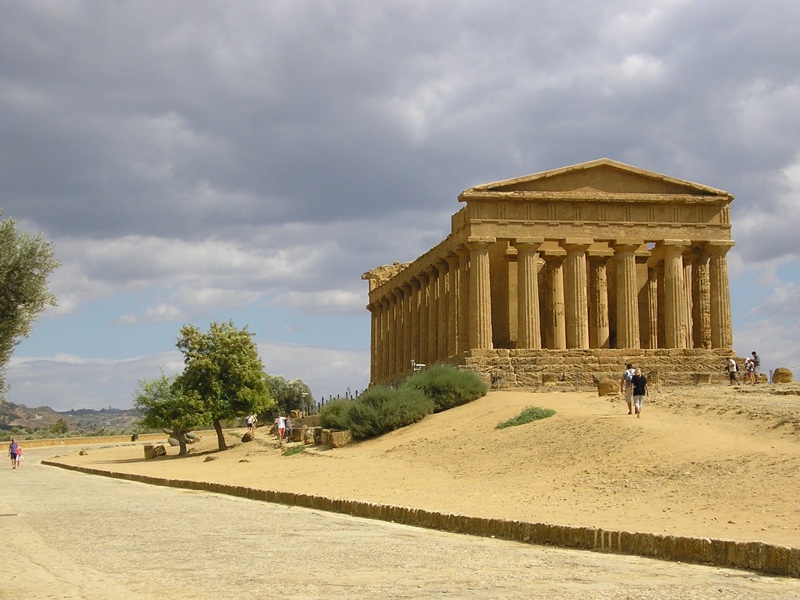
 (the name comes from a Latin inscription found nearby about some agreements between the contested parties). The temple dates from the 5th century BC; it was destroyed during the invasion of Carthage, but was rebuilt in Roman times, and in 597 CE transformed into a Christian basilica. Further, near the parking lot marked with the marker
(the name comes from a Latin inscription found nearby about some agreements between the contested parties). The temple dates from the 5th century BC; it was destroyed during the invasion of Carthage, but was rebuilt in Roman times, and in 597 CE transformed into a Christian basilica. Further, near the parking lot marked with the marker  (with numerous columns and even with an architrave resting on the colonnade on the north side), dating from the 5th century BC, also destroyed in 406 BC, but later rebuilt.
(with numerous columns and even with an architrave resting on the colonnade on the north side), dating from the 5th century BC, also destroyed in 406 BC, but later rebuilt.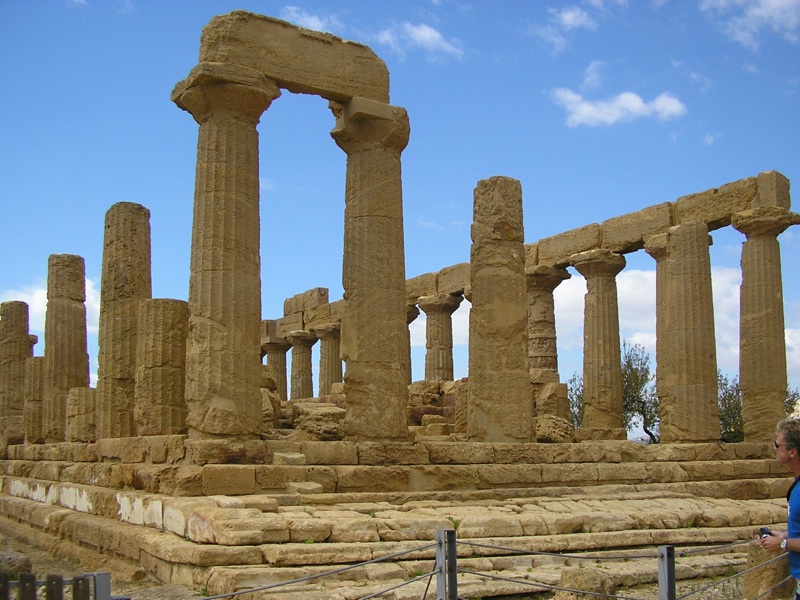
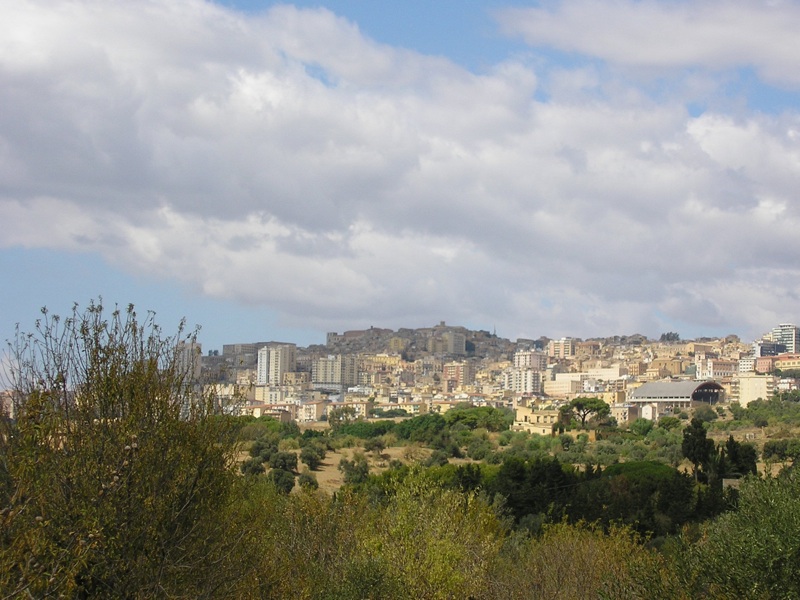
 (Cattedrale di San Gerlando), whose history dates back to the 11th century BC; the oldest fragments of the building erected in Norman times can be seen from the Via Duomo (later the temple was rebuilt and restored many times). Other churches of Agrigento worth seeing include Santa Maria dei Greci
(Cattedrale di San Gerlando), whose history dates back to the 11th century BC; the oldest fragments of the building erected in Norman times can be seen from the Via Duomo (later the temple was rebuilt and restored many times). Other churches of Agrigento worth seeing include Santa Maria dei Greci  , a 14th century temple with the relics of the Greek temple where it was built, the 18th century church of San Lorenzo
, a 14th century temple with the relics of the Greek temple where it was built, the 18th century church of San Lorenzo  (also with the remains of an earlier temple), as well as the church of Santo Spirito founded in the 13th century
(also with the remains of an earlier temple), as well as the church of Santo Spirito founded in the 13th century  and the adjoining Cistercian monastery. South of the cathedral, at the marker
and the adjoining Cistercian monastery. South of the cathedral, at the marker  , is Piazza Pirandello; the imposing building on this square houses the town hall, Municipio, and Agrigento's most important theater, Teatro Pirandello. Walking from here one of the main shopping streets of Agrigento, Via Atenea
, is Piazza Pirandello; the imposing building on this square houses the town hall, Municipio, and Agrigento's most important theater, Teatro Pirandello. Walking from here one of the main shopping streets of Agrigento, Via Atenea  , to the southeast, after a few dozen minutes you reach a large square adjacent to the even larger Piazza square Vittorio Emanuele
, to the southeast, after a few dozen minutes you reach a large square adjacent to the even larger Piazza square Vittorio Emanuele  , which forms the border between the historic districts of Agrigento (west of it) and the newer parts of the city.
, which forms the border between the historic districts of Agrigento (west of it) and the newer parts of the city. , a town named after Empedocles (one of the most important philosophers of Greek before Socrates, born around 490 BCE in Akragas). The town itself is not particularly interesting; however, it is worth knowing that when driving from Agrigento towards Porto Empedocle you drive close to the place (marked with the marker
, a town named after Empedocles (one of the most important philosophers of Greek before Socrates, born around 490 BCE in Akragas). The town itself is not particularly interesting; however, it is worth knowing that when driving from Agrigento towards Porto Empedocle you drive close to the place (marked with the marker  ) where the farmhouse stands in which the Italian playwright, laureate of the Nobel Prize in Literature, Luigi Pirandello, was born (part of the building is occupied by a museum devoted to the writer). Anyone interested in visiting this place should take the SS115qtr towards Porto Empedocle, head towards Villaseta and look for the appropriate signs for "Casa Natale de Luigi Pirandello".
) where the farmhouse stands in which the Italian playwright, laureate of the Nobel Prize in Literature, Luigi Pirandello, was born (part of the building is occupied by a museum devoted to the writer). Anyone interested in visiting this place should take the SS115qtr towards Porto Empedocle, head towards Villaseta and look for the appropriate signs for "Casa Natale de Luigi Pirandello".
